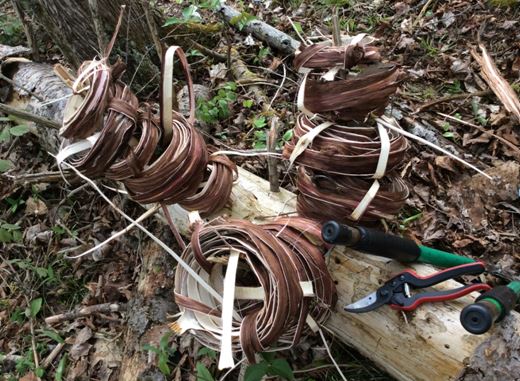Spring is always a busy time of year, and in my basket weaving life it is even busier! All winter long I gather willow and vines, and soak many, many yards of bark, before happily constructing a large variety of spoked baskets. Once Spring arrives, I start to notice changes in the materials that I gather and use all winter. The willows sport pussy willows, quickly followed by leaves. The dogwood loses its lovely red colour, and the outside temperature starts getting pleasantly warmer. These are all signs that its time to put my basket weaving on hold and start to plan my once yearly, cedar bark gathering.
The arrival of spring means that it is time for me to refocus, and put my energy and time into replenishing my stock of cedar bark. Cedar bark can only be gathered during a short window of time anywhere from late April to late May. During this time, the sap is running in the bark, but it is not yet sticky. Sticky bark is hard to peel and separate, and who wants a sticky basket? This window of time is dependent on the warming temperatures of spring, so every year it is a guessing game to determine when to start peeling.

This year I have plans to make some trails on my property suitable for dog-sledding, and several cedars are in the way. If I don’t cut them down this spring and harvest the bark, those trees will be knocked down later this summer, and by then the bark will no longer be useful for basket making. So, I have been very busy cutting down and peeling cedar trees. This year I have the luxury of more time to spend gathering bark. I have been able to peel the bark from the tree and then immediately remove the outer bark from the inner bark while the bark is still moist and flexible. The outer bark is not useful, but the inner bark is well worth the time spent to gather and process it. Cedar bark peels off the tree in a lengthwise direction. When first peeled, the inner bark is a creamy white colour and feels wet and slippery, but not sticky. I remove the outer bark and coil each strip of inner bark and tuck in the ends to contain the coil. I then bundle the coils together and hang the bundle to dry in my studio. As it slowly dries out, the bark turns a golden honey colour, and becomes stiff and inflexible. In this state it can be stored in my studio for many years until I’m ready to use it.
Sandi will be in the gallery next on June 3rd.

